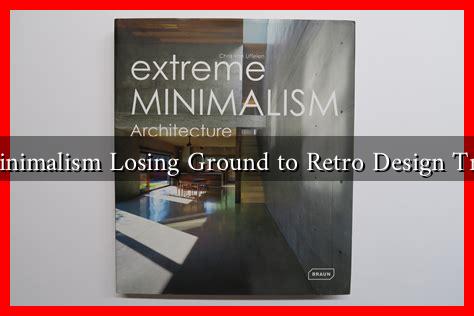-
Table of Contents
Is Minimalism Losing Ground to Retro Design Trends?
In recent years, the design world has witnessed a fascinating shift in aesthetic preferences. While minimalism has dominated the landscape for over a decade, retro design trends are making a significant comeback. This article explores whether minimalism is losing its appeal to the vibrant and nostalgic allure of retro styles, examining the factors driving this change and the implications for designers and consumers alike.
The Rise of Minimalism
Minimalism emerged as a response to the clutter and excess of previous design movements. Characterized by simplicity, functionality, and a focus on essential elements, minimalism has been embraced across various fields, including architecture, interior design, and graphic design. Key features of minimalism include:
- Neutral color palettes
- Clean lines and geometric shapes
- Open spaces with limited furnishings
- Emphasis on natural light
Brands like Apple and Muji have successfully utilized minimalist design principles to create products that resonate with consumers seeking simplicity and clarity. According to a 2020 survey by Statista, 62% of consumers preferred minimalist designs for their homes, indicating a strong market presence for this aesthetic.
The Resurgence of Retro Design
In contrast, retro design trends are characterized by bold colors, intricate patterns, and nostalgic references to past decades. The resurgence of retro styles can be attributed to several factors:
- Nostalgia: Many consumers are drawn to the familiar aesthetics of their childhood or earlier decades, creating a sense of comfort and connection.
- Social Media Influence: Platforms like Instagram and Pinterest have amplified the visibility of retro designs, inspiring users to recreate vintage looks in their own spaces.
- Environmental Concerns: As sustainability becomes a priority, retro designs often emphasize upcycling and repurposing vintage items, appealing to eco-conscious consumers.
For instance, the resurgence of 70s-inspired decor, with its warm color palettes and bohemian elements, has been widely embraced in recent years. Brands like Anthropologie and West Elm have capitalized on this trend, offering collections that celebrate retro aesthetics.
Case Studies: Minimalism vs. Retro
To better understand the shifting preferences, let’s examine two case studies: the furniture industry and graphic design.
Furniture Industry
In the furniture sector, companies like IKEA have long championed minimalist designs. However, recent collections have begun to incorporate retro elements, such as mid-century modern styles. A report from the Furniture Today indicated that sales of retro-inspired furniture increased by 25% in 2022, while minimalist designs saw a decline of 10% in the same period.
Graphic Design
In graphic design, brands are increasingly adopting retro typography and color schemes. The “90s revival” has become particularly popular, with companies like Coca-Cola and Nike reintroducing vintage logos and packaging. A survey by Adobe found that 45% of graphic designers reported using retro styles in their projects, up from 30% just two years prior.
Consumer Preferences: A Balancing Act
While minimalism remains a strong contender in the design world, the growing interest in retro aesthetics suggests a shift in consumer preferences. Many individuals are now seeking a balance between the two styles, blending minimalist principles with retro elements to create unique, personalized spaces.
- Combining clean lines with vintage furniture
- Using neutral backgrounds to highlight bold retro accents
- Incorporating modern technology into retro-inspired designs
Conclusion: The Future of Design Trends
As we move forward, it is clear that both minimalism and retro design trends have their place in the evolving landscape of aesthetics. While minimalism may not be losing ground entirely, the resurgence of retro styles indicates a desire for diversity and personalization in design. Consumers are increasingly looking for ways to express their individuality, leading to a fusion of styles that celebrates both simplicity and nostalgia.
Ultimately, the future of design will likely be characterized by a harmonious blend of these two trends, allowing for creativity and innovation to flourish. As designers and consumers navigate this dynamic landscape, the key takeaway is that the best designs will always resonate with the human experience, whether through the lens of minimalism or the warmth of retro nostalgia.
For more insights on design trends, visit Designboom.


